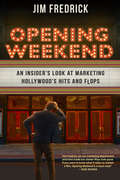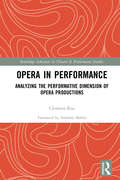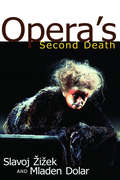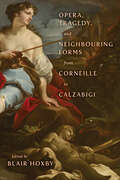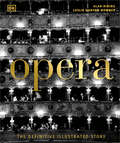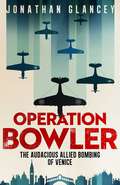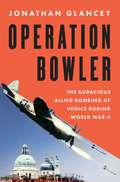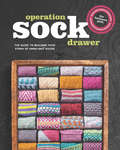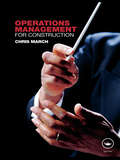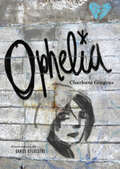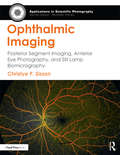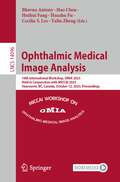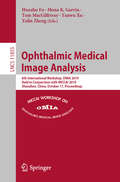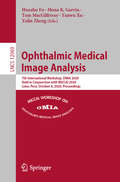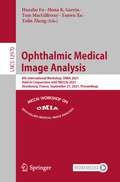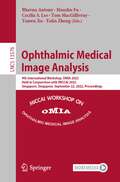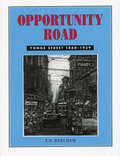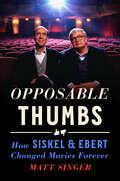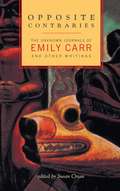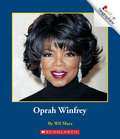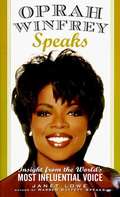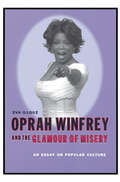- Table View
- List View
Opening Weekend: An Insider's Look at Marketing Hollywood's Hits and Flops
by Jim FredrickIn a world where movie marketers are the stars of the story, Opening Weekend: An Insider's Look at Marketing Hollywood's Hits and Flops recounts Jim Fredrick’s journey through the realm of movie marketing. Fredrick offers readers exclusive access to behind-the-scenes anecdotes and firsthand accounts of working with studio executives and navigating relationships with famous movie stars and directors.After starting his career in 1983 as a trailer editor and producer at famed advertising boutique Intralink, Jim Fredrick went on to serve as president of marketing at Castle Rock Entertainment; senior vice president of creative advertising at Warner Bros.; and executive vice president of marketing at Sony Screen Gems. In 2011, he founded his own company, Jim Fredrick Motion Picture Marketing. Across a span of thirty-five years, Fredrick’s roles as a trailer maker and studio executive allowed him to craft advertising campaigns for a range of movies, from such iconic cinematic gems as The Shawshank Redemption to the widely beloved Harry Potter franchise, to commercial failures like The Adventures of Pluto Nash and Fired Up! Opening Weekend explores the intricacies of the lesser-known business of film distribution and marketing, unraveling the complex mechanisms through which movies are sold to discriminating audiences. Replete with triumphs, setbacks, and the relentless spirit that drives the creation and promotion of cinematic masterpieces, Opening Weekend promises an enthralling glimpse into the previously untold world of Hollywood movies.
Opera in Performance: Analyzing the Performative Dimension of Opera Productions (Routledge Advances in Theatre & Performance Studies)
by Clemens RisiOpera in Performance elucidates the performative dimension of contemporary opera productions. What are the most striking and decisive moments in a performance? Why do we respond so strongly to stagings that transform familiar scenes, to performers’ bodily presence, and to virtuosic voices as well as ill-disposed ones? Drawing on phenomenology and performance theory, Clemens Risi explains how these moments arise out of a dialogue between performers and the audience, representation and presence, the familiar and the new. He then applies these insights in critical descriptions of his own experiences of various singers, stagings, and performances at opera houses and festivals from across the German-speaking world over the last twenty years. As the first book to focus on what happens in performance as such, this study shifts our attention to moments that have eluded articulation and provides tools for describing our own experiences when we go to the opera. This book will particularly interest scholars and students in theater and performance studies, musicology, and the humanities, and may also appeal to operagoers and theater professionals.
Opera's Second Death
by Slavoj Zizek Mladen DolarOpera's Second Death is a passionate exploration of opera - the genre, its masterpieces, and the nature of death. Using a dazzling array of tools, Slavoj Zizek and coauthor Mladen Dolar explore the strange compulsions that overpower characters in Mozart and Wagner, as well as our own desires to die and to go to the opera.
Opera, Tragedy, and Neighbouring Forms from Corneille to Calzabigi
by Blair HoxbySince the nineteenth century, some of the most influential historians have portrayed opera and tragedy as wholly distinct cultural phenomena. These historians have denied a meaningful connection between the tragedy of the ancients and the efforts of early modern composers to arrive at styles that were intensely dramatic. Drawing on a series of case studies, Opera, Tragedy, and Neighbouring Forms from Corneille to Calzabigi traces the productive, if at times rivalrous, relationship between opera and tragedy from the institution of French regular tragedy under Richelieu in the 1630s to the reform of opera championed by Calzabigi and Gluck in the late eighteenth century. Blair Hoxby and his fellow contributors shed light on “neighbouring forms” of theatre, including pastoral drama, tragédie en machines, tragédie en musique, and Goldoni’s dramma giocoso. Their analysis includes famous masterpieces by Corneille, Voltaire, Metastasio, Goldoni, Calzabigi, Handel, and Gluck, as well as lesser-known artists such as Luisa Bergalli, the first female librettist to write for the public theatre in Italy. Opera, Tragedy, and Neighbouring Forms from Corneille to Calzabigi delves into a series of quarrels and debates in order to illuminate the history of seventeenth- and eighteenth-century theatre.
Opera: The Definitive Illustrated History
by Leslie Dunton-Downer Alan RidingExperience the passion and drama of the world&’s greatest operas with this sumptuously illustrated visual guide.Immerse yourself in more than 400 years of the world&’s most celebrated operas and discover the fascinating stories behind them. Explore the lives of singers such as Maria Callas, Luciano Pavarotti, and Jonas Kaufmann. Meet composers like Mozart, Wagner, and Britten, and the librettists with whom they collaborated to create the magical blend of words and music that make up opera.From its origins in the 17th-century courts of Italy to live screenings in public spaces today, Opera: The Definitive Illustrated Story follows the history of opera from Monteverdi&’s L'Orfeo in 1607, to Cosi fan Tutte, La Bohème, and modern operas such as Brokeback Mountain. It explains musical terminology, traces historical developments, and sets everything in a cultural context.This awe-inspiring opera book further features:-Includes all of the most important operas from the Renaissance to the 21st century-Profiles the key composers, librettists, performers, and companies, with details of their lives, works, and influence-Arranged in chronological order to show the evolution of the genre-Clear, informative explanation of musical terminology and different types of operaThis book revels in the sets and costumes that make up the grand spectacle of opera. It also explores the great opera houses of the world, such as La Scala, Milan, the Met in New York, and the Sydney Opera House. Opera: The Definitive Illustrated Story is the essential book for anyone who wants to understand and enjoy the constantly evolving world of this beloved art form.Did you know that there are more than 25,000 opera performances per year worldwide? Opera: The Definitive Illustrated Story can be regarded as the most lavishly illustrated history of opera currently available, covering all of the most important operas from the Renaissance to the 21st century, and is completely global in scope. A must-have volume for opera buffs, whether as a gift or self-purchase, if you&’re a music lover looking for an accessible introduction to opera, then this is the book for you!
Operation Bowler: The Audacious Allied Bombing of Venice
by Jonathan Glancey21st March 1945. 1530 hours. Bursting through a hazy sky, dozens of Allied fighters and bombers sweep over German-occupied Venice. Their mission – destroy Germany&’s strategic outposts nestled along the port, while leaving the floating city unscathed. As bombs rained down upon Europe, flattening city after city, Venice – La Serenissima; home of Titian and Veronese; immortalised in the serene landscapes of Canaletto – remained sacrosanct. Its artistic and architectural treasure too considerable, too precious to risk destruction. But, as the push up through Italy reached its final, gruelling months, the Allies were confronted with a terrible dilemma. The ancient city of Venice was now closer and closer to the line of fire. As casualties mounted, the value of art, of history seemed diminished – just a month earlier Allied bombers had reduced the ancient hilltop abbey of Monte Cassino to a stony husk. In a gripping tale, bestselling author Jonathan Glancey reveals the thrilling history of &‘Operation Bowler&’. Joining audacious Wing Commander George Westlake DFC and his elite team, Operation Bowler explores how an unlikely squad of pilots executed one of the most meticulous and complex air raids of the Second World War, sparing not only Venice, but its people.
Operation Bowler: The Audacious Allied Bombing of Venice during World War II
by Jonathan GlanceyA story of incredible military daring—set against the splendor of Venice—that tells how an unlikely squad of pilots executed the most meticulous air raid of World War II.March 21st, 1945. Bursting through a hazy sky, dozens of Allied fighters and bombers sweep over German-occupied Venice. Their mission: destroy Germany&’s strategic outposts nestled along the port, while leaving the floating city unscathed. As bombs rained down upon Europe, flattening city after city, Venice—La Serenissima; home of Titian and Veronese; immortalized in the serene landscapes of Canaletto—remained sacrosanct. Its artistic and architectural treasure too considerable, too precious to risk destruction. But as the push up through Italy reached its final, grueling months, the Allies were confronted with a terrible dilemma. The ancient city of Venice was now closer and closer to the line of fire. As casualties mounted, the value of art—of history—seemed diminished; just a month earlier Allied bombers had reduced the ancient hilltop abbey of Monte Cassino to a stony husk. In this vivid narrative, bestselling author Jonathan Glancey reveals the thrilling story of Operation Bowler. Following the exploits of audacious Wing Commander George Westlake and his elite team, Operation Bowler explores how an unlikely squad of pilots executed perhaps the most meticulous and complex air raid of World War II, sparing not only Venice but also its people.
Operation Sock Drawer: The Guide to Building Your Stash of Hand-Knit Socks
by Knitmore GirlsKnit yourself a drawer of beautiful socks with the Knitmore Girls Inspired by the gorgeous sock drawers of Susan B. Anderson, Jasmin and Gigi of The Knitmore Girls podcast started the hashtag #operationsockdrawer in an effort to knit a collection of socks just as photo worthy. Tens of thousands of knitters have since joined the campaign to knit more pretty socks and the hashtag has grown to more than 200k tags on social media. Think of Operation Sock Drawer as your sock knitting survival guide. In it you'll find: • 20 original designer sock patterns--more than enough to fill your first drawer. • Great how-ton information on knitting a variety of toe shapes, heel styles, options for comfortable ankles, and more! • Darn it! Don't toss old socks, repair them with simple darning techniques. • Bonus information on knitting socks two at a time, how to make great yarn to pattern matches, and how to overcome second sock syndrome. Grab your needles and a skein of yarn, and then join The Knitmore Girls on their mission to expand sock collections around the globe.
Operation of Smart Homes (Power Systems)
by Mehdi Rahmani-AndebiliThis book presents the latest research advancements in the operation of smart homes. It comprises new operation techniques including cooperative distributed energy scheduling, framework to react to malicious cyberattacks, framework for demand-side management, and framework for the design of smart homes to support residents’ wellness as well as new optimization techniques such as stochastic model predictive control and multi-time scale optimization. In addition, the book analyzes 11,000 studies that have been indexed in scientific databases and categorizes them based on various data points, including the field and the subject of the research, the name of the institutions, and the nationality of the authors.Presents new operation techniques of smart homes;Introduces new optimization techniques for operation of smart homes;Analyses 11,000 studies and categorizes them based on different data points.
Operational Images: From the Visual to the Invisual
by Jussi ParikkaAn in-depth look into the transformation of visual culture and digital aesthetics First introduced by the German filmmaker Harun Farocki, the term operational images defines the expanding field of machine vision. In this study, media theorist Jussi Parikka develops Farocki&’s initial concept by considering the extent to which operational images have pervaded today&’s visual culture, outlining how data technologies continue to develop and disrupt our understanding of images beyond representation.Charting the ways that operational images have been employed throughout a variety of fields and historical epochs, Parikka details their many roles as technologies of analysis, capture, measurement, diagramming, laboring, (machine) learning, identification, tracking, and destruction. He demonstrates how, though inextricable from issues of power and control, operational images extend their reach far beyond militaristic and colonial violence and into the realms of artificial intelligence, data, and numerous aspects of art, media, and everyday visual culture.Serving as an extensive guide to a key concept in contemporary art, design, and media theory, Operational Images explores the implications of machine vision and the limits of human agency. Through a wealth of case studies highlighting the areas where imagery and data intersect, this book gives us unprecedented insight into the ever-evolving world of posthuman visuality. Cover alt text: Satellite photo on which white title words appear in yellow boxes. Yellow lines connect the boxes.
Operations Management for Construction
by Chris MarchStudents studying construction management and related subjects need to have a broad understanding of the major aspects of controlling the building processes. Operations Management for Construction is one of three textbooks (Business Organisation, Operations Management and Finance Control) written to systematically cover the field. Focusing on construction sites and operations which are challenging to run, Chris March explores issues such as the setting up of the site, the deciding of the methodology of construction, and the sequence of work and resourcing. As changing and increasing regulations affect the way sites are managed, he also considers the issues and methods of successful administering, safety, quality and environment. Finally, the contractor’s responsibility to the environment, including relationships with third parties, selection of materials, waste management and sustainability is discussed. Chris March has a wealth of practical experience in the construction industry, as well as considerable experience of teaching, which he uses to support the theory and principles set out in the book.
Ophelia
by Charlotte Gingras“...explore how painting, writing, and building things with your hands can be the outlet that helps a person get through the hell that is high school.” — Quill & QuireThe kids at school call her rag girl because she hides under layers of oversized clothing, but she calls herself Ophelia. She hardly speaks to anyone — until one day a visiting author comes to give a talk in the school library. The writer speaks about what it means to create art, and at the end of her talk, she thanks Ophelia for asking the first question by giving her a blue notebook with her address on it.Ophelia starts to write to the author in the notebook — letters that become a kind of lifeline. The idea that someone, somewhere, might care, is enough for her to keep writing, an escape from her real life. By day she goes to school and works at the dollar store before returning home to her mother, a former addict who once had to put her daughter in care. At night she creates graffiti around town, leaving little broken hearts as her tag.One night she finds an abandoned building that she decides to use as her workshop, where she can make larger-than-life art. When she finds that a classmate, an overweight boy named Ulysses, is also using the space to repair an old van, the two form an uneasy truce, with a chalk line drawn down the middle to mark their separate territories. As time passes, Ophelia and Ulysses forge a fraught but growing friendship, but their cocooned existence cannot last forever. One night, intruders invade their sanctuary, and their shared bond and individual strength are sorely tested.Key Text FeaturesillustrationsdoodlessketchesphotographsCorrelates to the Common Core State Standards in English Language Arts:CCSS.ELA-LITERACY.RL.6.3Describe how a particular story's or drama's plot unfolds in a series of episodes as well as how the characters respond or change as the plot moves toward a resolution.
Ophthalmic Imaging: Posterior Segment Imaging, Anterior Eye Photography, and Slit Lamp Biomicrography (Applications in Scientific Photography)
by Christye SissonOphthalmic Imaging serves as a reference for the practicing ophthalmic imager. Ophthalmic imaging combines photography and diagnostic imaging to provide insight into not only the health of the eye, but also the health of the human body as a whole. Ophthalmic photographers are specialists in imaging through and in the human eye, one of the only parts of the body where the circulation and nervous system is visible non-invasively. With technical perspective as context, this book will provide instructional techniques as well as the background needed for problem solving in this exciting field. The book covers all aspects of contemporary ophthalmic imaging and provides image support to ophthalmologists and sub-specialties including retinal specialists, corneal specialists, neuro-ophthalmologists, and ocular oncologists. This text serves as a reference for the practicing ophthalmic imager, or to imagers just getting started in the field.
Ophthalmic Medical Image Analysis: 10th International Workshop, OMIA 2023, Held in Conjunction with MICCAI 2023, Vancouver, BC, Canada, October 12, 2023, Proceedings (Lecture Notes in Computer Science #14096)
by Huazhu Fu Yalin Zheng Hao Chen Bhavna Antony Cecilia S. Lee Huihui FangThis book constitutes the refereed proceedings of the 10th International Workshop on Ophthalmic Medical Image Analysis, OMIA 2023, held in conjunction with the 26th International Conference on Medical Imaging and Computer-Assisted Intervention, MICCAI 2023, in Vancouver, Canada, in October 2023.The 16 papers presented at OMIA 2023 were carefully reviewed and selected from 27 submissions. The papers cover various topics in the field of ophthalmic medical image analysis and challenges in terms of reliability and validation, number and type of conditions considered, multi-modal analysis (e.g., fundus, optical coherence tomography, scanning laser ophthalmoscopy), novel imaging technologies, and the effective transfer of advanced computer vision and machine learning technologies.
Ophthalmic Medical Image Analysis: 6th International Workshop, OMIA 2019, Held in Conjunction with MICCAI 2019, Shenzhen, China, October 17, Proceedings (Lecture Notes in Computer Science #11855)
by Yanwu Xu Mona K. Garvin Huazhu Fu Tom MacGillivray Yalin ZhengThis book constitutes the refereed proceedings of the 6th International Workshop on Ophthalmic Medical Image Analysis, OMIA 2019, held in conjunction with the 22nd International Conference on Medical Imaging and Computer-Assisted Intervention, MICCAI 2019, in Shenzhen, China, in October 2019. The 22 full papers (out of 36 submissions) presented at OMIA 2019 were carefully reviewed and selected. The papers cover various topics in the field of ophthalmic image analysis.
Ophthalmic Medical Image Analysis: 7th International Workshop, OMIA 2020, Held in Conjunction with MICCAI 2020, Lima, Peru, October 8, 2020, Proceedings (Lecture Notes in Computer Science #12069)
by Yanwu Xu Mona K. Garvin Huazhu Fu Tom MacGillivray Yalin ZhengThis book constitutes the refereed proceedings of the 6th International Workshop on Ophthalmic Medical Image Analysis, OMIA 2020, held in conjunction with the 23rd International Conference on Medical Imaging and Computer-Assisted Intervention, MICCAI 2020, in Lima, Peru, in October 2020. The workshop was held virtually due to the COVID-19 crisis.The 21 papers presented at OMIA 2020 were carefully reviewed and selected from 34 submissions. The papers cover various topics in the field of ophthalmic medical image analysis and challenges in terms of reliability and validation, number and type of conditions considered, multi-modal analysis (e.g., fundus, optical coherence tomography, scanning laser ophthalmoscopy), novel imaging technologies, and the effective transfer of advanced computer vision and machine learning technologies.
Ophthalmic Medical Image Analysis: 8th International Workshop, OMIA 2021, Held in Conjunction with MICCAI 2021, Strasbourg, France, September 27, 2021, Proceedings (Lecture Notes in Computer Science #12970)
by Yanwu Xu Mona K. Garvin Huazhu Fu Tom MacGillivray Yalin ZhengThis book constitutes the refereed proceedings of the 8th International Workshop on Ophthalmic Medical Image Analysis, OMIA 2021, held in conjunction with the 24th International Conference on Medical Imaging and Computer-Assisted Intervention, MICCAI 2021, in Strasbourg, France, in September 2021.* The 20 papers presented at OMIA 2021 were carefully reviewed and selected from 31 submissions. The papers cover various topics in the field of ophthalmic medical image analysis and challenges in terms of reliability and validation, number and type of conditions considered, multi-modal analysis (e.g., fundus, optical coherence tomography, scanning laser ophthalmoscopy), novel imaging technologies, and the effective transfer of advanced computer vision and machine learning technologies. *The workshop was held virtually.
Ophthalmic Medical Image Analysis: 9th International Workshop, OMIA 2022, Held in Conjunction with MICCAI 2022, Singapore, Singapore, September 22, 2022, Proceedings (Lecture Notes in Computer Science #13576)
by Yanwu Xu Huazhu Fu Tom MacGillivray Yalin Zheng Bhavna Antony Cecilia S. LeeThis book constitutes the refereed proceedings of the 9th International Workshop on Ophthalmic Medical Image Analysis, OMIA 2022, held in conjunction with the 25th International Conference on Medical Imaging and Computer-Assisted Intervention, MICCAI 2022, in Singapore, Singapore, in September 2022.The 20 papers presented at OMIA 2022 were carefully reviewed and selected from 33 submissions. The papers cover various topics in the field of ophthalmic medical image analysis and challenges in terms of reliability and validation, number and type of conditions considered, multi-modal analysis (e.g., fundus, optical coherence tomography, scanning laser ophthalmoscopy), novel imaging technologies, and the effective transfer of advanced computer vision and machine learning technologies.
Opportunity Road: Yonge Street 1860-1939
by F. R. Hamish BerchemThis important original work with stylish illustrations by the author/artist F.R. (Hamish) Berchem, promises to be a worthy sequel to his earlier book on Yonge Street, The Yonge Street Story 1793-1860 (now out of print).The fascinating story of Yonge Street has involved an endless array of memorable personalities including the young reporter Charles Dickens; publisher J. Ross Robertson; successful Scots merchants John MacDonald, John Catto, Robert Simpson and Irishman Timothy Eaton; coal and wood merchant Elias Rogers; Hessian officer Frederic, Baron de Hoen; theatre magnate Ambrose Small; and soldier, financier, philanthropist Major General Sir Henry Pellatt.This is also the story of some of the communities that dot the northward route of Yonge Street from Toronto - Richmond Hill, Thornhill, Aurora, Newmarket, Holland Landing, Bradford and Penetanguishene, the latter for many years the northern terminus of Yonge Street. Today, as Highway 11, the world’s longest street winds its way through Ontario’s "Near North" to Rainy River, a remarkable tribute to the vision of Lieutenant Governor John Graves Simcoe.
Opposable Thumbs: How Siskel & Ebert Changed Movies Forever
by Matt SingerOnce upon a time, if you wanted to know if a movie was worth seeing, you didn&’t check out Rotten Tomatoes or IMDB.You asked whether Siskel & Ebert had given it &“two thumbs up.&”On a cold Saturday afternoon in 1975, two men (who had known each other for eight years before they&’d ever exchanged a word) met for lunch in a Chicago pub. Gene Siskel was the film critic for the Chicago Tribune. Roger Ebert had recently won the Pulitzer Prize—the first ever awarded to a film critic—for his work at the Chicago Sun-Times. To say they despised each other was an understatement.When they reluctantly agreed to collaborate on a new movie review show with PBS, there was at least as much sparring off-camera as on. No decision—from which films to cover to who would read the lead review to how to pronounce foreign titles—was made without conflict, but their often-antagonistic partnership (which later transformed into genuine friendship) made for great television. In the years that followed, their signature &“Two thumbs up!&” would become the most trusted critical brand in Hollywood.In Opposable Thumbs, award-winning editor and film critic Matt Singer eavesdrops on their iconic balcony set, detailing their rise from making a few hundred dollars a week on local Chicago PBS to securing multimillion-dollar contracts for a syndicated series (a move that convinced a young local host named Oprah Winfrey to do the same). Their partnership was cut short when Gene Siskel passed away in February of 1999 after a battle with brain cancer that he&’d kept secret from everyone outside his immediate family—including Roger Ebert, who never got to say goodbye to his longtime partner. But their influence on in the way we talk about (and think about) movies continues to this day.
Opposite Contraries
by Emily Carr Susan CreanCollected from Emily Carr's private and public writings, these previously unpublished pieces reveal the outspoken artist at her most forthright. Expurgated sections from Carr's journals detail her anguished meditations on her spiritual mission, musings about Native culture and the white community's reaction to it, and thoughts about her family. Her groundbreaking 1913 "Lecture on Totems", her first recorded writing on Native art and people, is also included, as are some of her most fascinating letters to friends and colleagues.
Oprah Winfrey
by Wil MaraThe Rookie Biographies series features historical and contemporary people who will captivate emergent readers. Each biography introduces readers to the lives and achievements of pioneering men and women from diverse cultures, eras, and fields. Featuring simple text and full-color photographs, a "Words You Know" glossary, and an easy-to-use index, this series helps readers get to know the people who shaped our world. In this title, young readers will learn about Oprah Winfrey's rags to riches story. Discover how Winfrey grew up in poverty but, while attending college, discovered her talent as a news reporter and talk show host. Now, Winfrey's show is one of the most watched on daytime television, she owns a production company, and publishes a magazine.
Oprah Winfrey Speaks: Insight from the World's Most Influential Voice
by Janet LoweOprah is not just another famous entertainer. She's a friend to the world and a role model for all people, of any gender, of any race, of any group. Before reading Oprah Winfrey Speaks, here are some guidelines on what to expect from the book. It will not be focused on the well-known details of Oprah's life and rise to stardom, although this information is presented to give the reader a better perspective on the comments. Rather, the book emphasizes the lessons that Winfrey has learned along the way--lessons many of us can profit from. Oprah has taught us a lot, and I've tried to capture as much of that wisdom as possible.
Oprah Winfrey and the Glamour of Misery: An Essay on Popular Culture
by Eva IllouzOprah Winfrey is the protagonist of the story to be told here, but this book has broader intentions, begins Eva Illouz in this original examination of how and why this talk show host has become a pervasive symbol in American culture. Unlike studies of talk shows that decry debased cultural standards and impoverished political consciousness, Oprah Winfrey and the Glamour of Misery asks us to rethink our perceptions of culture in general and popular culture in particular.At a time when crises of morality, beliefs, value systems, and personal worth dominate both public and private spheres, Oprah's emergence as a cultural form—the Oprah persona—becomes clearer, as she successfully reiterates some of our most pressing moral questions. Drawing on nearly one hundred show transcripts; a year and a half of watching the show regularly; and analysis of magazine articles, several biographies, O Magazine, Oprah Book Club novels, self-help manuals promoted on the show, and hundreds of discussions on the Oprah Winfrey Web site, Illouz takes the Oprah industry seriously, revealing it to be a multilayered "textual structure" that initiates, stages, and performs narratives of suffering and self-improvement that resonate with a wide audience and challenge traditional models of cultural analysis. This book looks closely at Oprah's method and her message, and in the process reconsiders popular culture and the tools we use to understand it.
Oprah Winfrey: The Real Story
by George MairAn exploration of the life and career of Oprah Winfrey.
